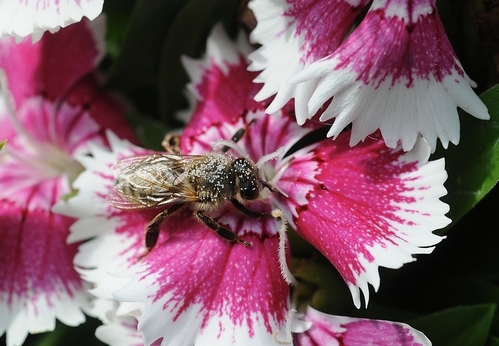By Barbara Ott, Butte County Master Gardener, February 19, 2016.
References to the plant genus Dianthus go back as far as the Greek botanist Theophrastus. He named these plants from the Caryophyllaceae family “divine flower” (dios = divine plus anthos = flower). The Romans brought Dianthus to Europe and England, and from there these plants were eventually brought to the New World. As it moved to new places, this world-travelling plant acquired a variety of names, including sweet William, pinks, gillyflower, cottage pink, carnation and clove pink.

Dianthus can contribute to garden design in many ways. Use dwarf and mat-forming varieties as edging for a border, in containers, in rock gardens, among patio pavers, as ground cover, or along rock walls. Medium-to-tall varieties are effective in flower borders, in gardens for cut flowers, and in front of shrubs. Combine Dianthus with plants that harmonize with its foliage and colors; good companions include coral bells, feverfew, lamb's-ear, larkspur, lavender, hardy geraniums, petunias, poppies, sage, and floribunda and shrub roses.
Dianthus is a culinary flower. Crystallized petals are used for decorating cakes, while fresh petals can be used in salads, pies, and sandwiches. It is important when using dianthus for culinary purposes to remove the petal base, which is quite bitter.
These varieties of Dianthus do well in our area:
- Sweet William is biennial. It is covered with spicy-smelling, bi-colored flowers in late spring and grows 12 to 18 inches tall. This flower seeds freely. If you don't want seed set, conscientiously deadhead after bloom. But if you love a spontaneous surprise in the garden, sweet William's freely-seeding behavior can provide new plants year after year.
- Cheddar and cottage pinks are perennial forms of Dianthus. Their foliage is blue-gray or green. Some varieties grow as low as 2 inches, others as tall as 16 inches. The low-growing varieties work well in rock gardens.
- Dianthus (D. chinensis), while technically a biennial, is used as an annual. It is low- growing with green foliage, and flowers for up to 8 weeks in the spring.
- Among the taller Dianthus, D. caryophyllus is the best known. This species includes the florists' carnation as well as border carnations.
All forms of Dianthus were characterized by short blooming seasons until 1971, when a breeder began to grow varieties that didn't set seed. These varieties typically bloom from May to October.
Whether you grow old fashioned pinks, sweet William, or hybrid Dianthus, know you are planting a water-wise plant that has graced gardens around the world for millennia.


